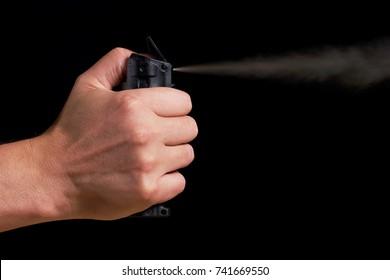Table of Contents
- Understanding the Anatomy of Pepper Spray for Effective Targeting
- Mastering Stance and Grip to Improve Aim Under Pressure
- Identifying Critical Target Areas for Maximum Impact
- Practicing Controlled Breathing and Focus to Enhance Accuracy
- Insights and Conclusions
Understanding the Anatomy of Pepper Spray for Effective Targeting
To use pepper spray effectively, understanding its internal components is crucial. At the core, pepper spray consists of a pressurized canister that houses a noxious oleoresin capsicum (OC) extract, suspended in a solvent. This mixture is expelled through a small nozzle that creates either a stream, cone, or fog pattern depending on the design. The size and shape of the nozzle directly influence the range and accuracy of the spray. By knowing how the spray is dispersed, you can better control your aim, ensuring the irritant hits the attacker’s eyes and respiratory system without unnecessary waste or self-exposure.
Key parts to focus on for precision targeting include:
- The actuator button, which controls the spray’s force and duration-quick, controlled bursts are more effective than continuous spraying.
- The nozzle, where the spray pattern is determined-stream nozzles offer the best accuracy but require steady hands.
- The canister pressure, which can affect range-attacking at the proper distance (typically 6-10 feet) maximizes impact and minimizes recoil.
Mastering these components through practice enables you to deploy pepper spray swiftly and with pinpoint accuracy, especially under high-stress situations. This anatomical awareness not only improves targeting but also enhances your defensive strategy by preserving spray capacity for multiple attempts if necessary.
Mastering Stance and Grip to Improve Aim Under Pressure
When it comes to accurate aiming in high-stress situations, establishing a solid foundation with your stance is crucial. Position your feet shoulder-width apart to create balance and stability, slightly bending your knees for better control. This grounding helps reduce the natural tremors that arise from anxiety or rapid movements, allowing for smoother targeting. Keep your body squared toward the threat, but avoid a rigid posture; flexibility will enable quick adjustments if needed. Remember, a well-practiced stance not only boosts precision but also enhances your confidence when every second counts.
Your grip on the pepper spray directly influences your ability to aim consistently. Use a firm, yet not overly tight, hold with your dominant hand-this ensures control without unnecessary muscle fatigue. Support this with your other hand by cupping around the canister or stabilizing your wrist, creating a two-handed grip that mitigates recoil and improves steadiness. Focus on keeping your fingers clear of the nozzle and trigger until you’re ready to deploy. Quick tip: incorporating specific grip drills into your practice can engrain muscle memory, so your hand naturally finds the optimal grip in any scenario.
- Feet shoulder-width apart for maximum stability
- Soft, bent knees to absorb shock and aid mobility
- Two-handed grip to steady your aim and reduce recoil
- Finger placement awareness to avoid accidental discharge
Identifying Critical Target Areas for Maximum Impact
When deploying pepper spray in a high-stress scenario, precision can make all the difference in incapacitating a threat swiftly and effectively. Focus your aim on areas of the body that are most vulnerable and sensitive, as these zones will maximize the spray’s deterrent effect. Eyes and face are primary targets because the active ingredients cause immediate irritation, tearing, and temporary blindness. This critical moment provides you with an opportunity to escape or call for help while the assailant is disoriented.
Besides the face, consider targeting other exposed areas to enhance effectiveness, such as the neck or hands, especially if the attacker is close enough to grab or restrain you. Below are key areas to consider:
- Eyes and nose: Causes maximum sensory disruption.
- Throat and neck: Adds surprise and can slow down breathing temporarily.
- Hands and arms: Disrupts the attacker’s ability to continue an assault.
Practicing Controlled Breathing and Focus to Enhance Accuracy
Mastering the art of controlled breathing is crucial when it comes to maintaining steady aim under pressure. In high-stress situations, your body’s natural fight-or-flight response can cause rapid, shallow breathing, leading to shaky hands and compromised accuracy. By consciously slowing your breath and focusing on deep, calm inhales and exhales, you reduce adrenaline spikes and enhance muscle control. This deliberate breathing not only steadies your body but also sharpens your mind, allowing you to better analyze the threat and aim with precision.
Alongside breathing, maintaining razor-sharp focus is essential for effective targeting. Distractions, whether external noise or internal panic, can blur your judgment. Develop a mental routine that includes:
- Visualizing your target before making your move
- Zeroing in on specific points such as an attacker’s eyes or torso
- Staying present by blocking out irrelevant stimuli
Insights and Conclusions
Mastering the skill of aiming pepper spray accurately in high-pressure situations is not just about technique-it’s about confidence, preparedness, and personal safety. By understanding proper stance, target zones, and practicing regularly, you can ensure that your response is both effective and swift when it matters most. Remember, pepper spray is a tool designed to give you a crucial advantage in threat situations, but success depends on your ability to use it precisely. Stay calm, stay focused, and keep practicing-your safety is worth it.Check Our Other Blogs
- StunGun – Your Trusted Source for Stun Guns, Laws, and Self-Defense Tips
- PepperSprayLaws – Your Trusted Resource for Pepper Spray Information
- StunGunLaws – Your Trusted Guide to Stun Gun Legality and Safety




